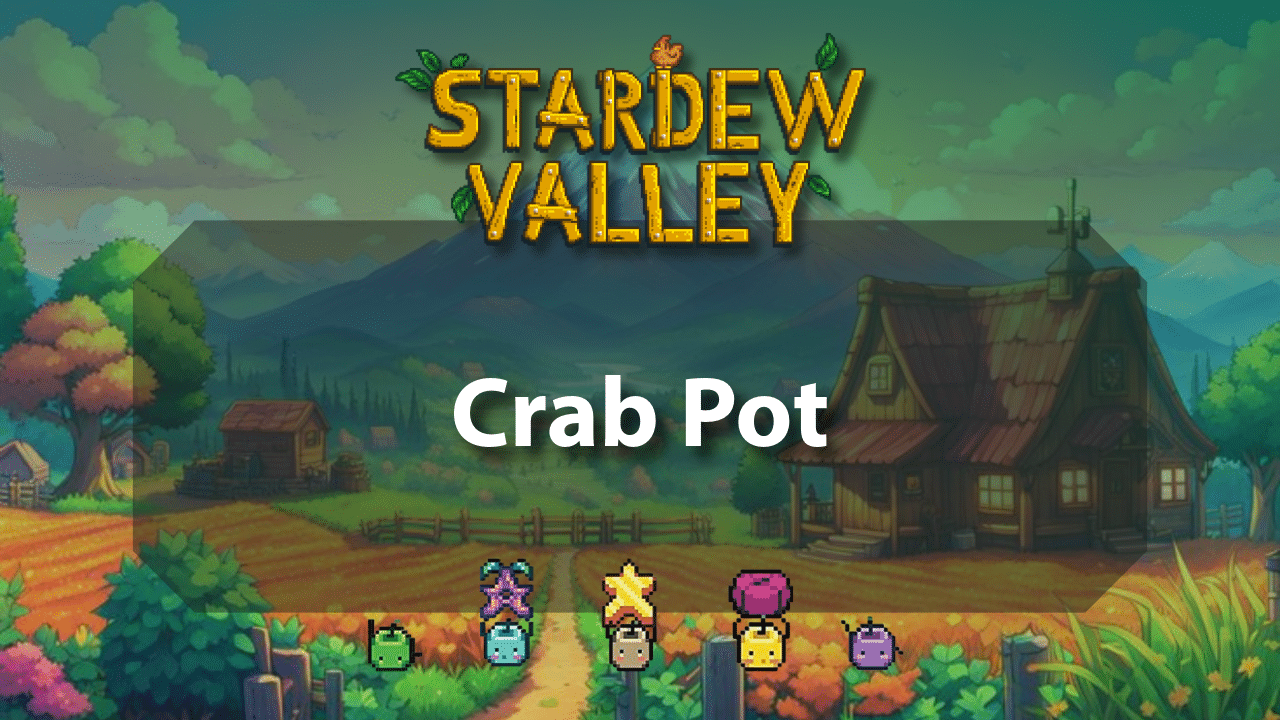
Introduction
The Stardew Valley Crab Pot is a useful tool for players looking to passively gather aquatic resources without actively fishing. These pots can be placed in rivers, lakes, or the ocean to catch a variety of sea creatures, including crabs, lobsters, mussels, and more, which can be sold, used in cooking, or gifted to villagers. To unlock the ability to craft a Crab Pot, players must reach Fishing Level 3, allowing them to make one using wood and iron bars. Alternatively, Crab Pots can be purchased from Willy’s shop for a set price. Each Stardew Valley Crab Pot requires bait to function unless the player has chosen the Luremaster profession, which removes this requirement.
Once placed and baited, the Crab Pot will yield a catch the following day, which can then be collected and reset with new bait. The Trapper profession reduces the crafting cost, making it easier to produce multiple pots for larger-scale passive fishing. Crab Pots placed in freshwater sources such as rivers and lakes will catch different creatures than those placed in the ocean, with freshwater locations yielding crayfish, snails, and periwinkles, while saltwater locations provide shrimp, lobsters, and crabs. Occasionally, trash items may be caught instead of sea creatures, but these can be recycled into useful materials using a Recycling Machine.
For efficiency, placing Crab Pots near frequently traveled areas, such as near the farm or in high-traffic fishing spots, makes daily collection easier. Incorporating Stardew Valley Crab Pots into your routine allows for a steady supply of seafood, providing ingredients for recipes, completing bundles in the Community Center, and earning additional income without requiring active fishing.
Unlocking and Obtaining Your First Crab Pots
Before you can start using the Stardew Valley Crab Pot, you’ll need to progress in your fishing skill. The crafting recipe for Crab Pots unlocks once you reach Fishing Level 3, allowing you to craft them using 40 wood and three iron bars. To level up your Fishing skill, you must catch fish using a rod in any body of water, gradually increasing your experience until you reach the required level.
Fishing takes time and patience, but reaching Level 3 early can help you gain access to Crab Pots sooner, adding a passive way to collect valuable seafood. If you prefer not to craft them, Crab Pots can also be purchased from Willy’s Fish Shop for 1,500 gold each, but this option only becomes available after reaching Fishing Level 3. This can be a convenient alternative for players who have extra gold and would rather invest in ready-made pots instead of gathering materials and crafting them.
For those focusing on completing the Community Center, the Crab Pot Bundle in the Fish Tank section provides another way to obtain Crab Pots. Completing this bundle rewards players with three free Crab Pots, which can be an excellent early boost for gathering aquatic resources without spending gold or crafting materials.
This bundle requires players to donate any five eligible shellfish or crustaceans, which can be caught using Crab Pots or found by foraging on the beach. Once you have your Crab Pots, you can place them in lakes, rivers, or the ocean, where they will passively catch creatures such as crabs, lobsters, crayfish, and snails, depending on the location. These catches can be used in cooking, gifted to villagers, sold for profit, or used to complete additional bundles in the Community Center.
To use a Crab Pot, you must place it in water and add bait, which ensures it will produce a catch the next day. The only exception is for players who choose the Luremaster profession at Fishing Level 10, which removes the need for bait entirely, making Crab Pots even more efficient. Another profession, Trapper, reduces the cost of crafting Crab Pots by replacing iron bars with copper bars, making it easier to mass-produce them. Some catches from Crab Pots, like lobsters and crabs, have higher selling prices, while others, such as periwinkles and snails, are useful for crafting or cooking.
Occasionally, Crab Pots will catch trash instead of seafood, but this can still be beneficial since trash can be recycled into valuable materials using a Recycling Machine. To maximize efficiency, it’s best to place Crab Pots in locations you visit frequently, such as near the farm or in high-traffic fishing spots, making daily collection easier. Incorporating the Stardew Valley Crab Pot into your routine provides a steady supply of seafood, additional income, and useful materials without requiring active fishing every day.
Crafting Your Own Traps
For the resourceful farmer, crafting a Stardew Valley Crab Pot can be a cost-effective option, especially for those planning to use multiple pots over time. The standard crafting recipe requires 40 wood and three iron bars. Wood is easily gathered by chopping trees on your farm or around Pelican Town, while iron bars are obtained by smelting iron ore in a furnace with one coal per bar. Iron ore can be found in the Mines, typically appearing more frequently on floors 41 and below. Crafting Crab Pots allows players to expand their fishing operations without relying on purchasing them from Willy’s Fish Shop.
MaterialStandard RecipeTrapper Profession RecipeReductionWood402515Iron Bars303Copper Bars02–For those looking to maximize efficiency, choosing the Trapper profession at Fishing Level 5 reduces the crafting cost of Crab Pots. With this profession, the recipe changes to require only 25 wood and two copper bars, making it easier to produce multiple pots early in the game. Copper ore is found in the Mines starting at floor 2 and is much more abundant than iron, making this an accessible crafting option for those focusing on Crab Pot fishing. Players who invest in a large number of Crab Pots may find the reduced crafting cost beneficial, allowing them to expand their collection faster without the need for as many higher-tier resources.
Crab Pots are a long-term investment, as they provide a passive way to gather seafood without requiring active fishing. Once placed in water and baited, they will catch shellfish and crustaceans, depending on whether they are in freshwater or saltwater. While crafting is a great way to build up a supply of Crab Pots, players should also consider the fixed price of purchasing them from Willy’s shop for 1,500 gold each, especially as resource costs increase in Year 2.
In some cases, buying Crab Pots instead of gathering materials may be a more efficient choice, particularly for players focused on earning gold through other means. Whether crafting or purchasing, incorporating Crab Pots into your routine can help diversify income, provide ingredients for recipes, and contribute to Community Center bundles.
Where to Cast Your Crabs
Once you have your Stardew Valley Crab Pots ready, choosing the right location to place them is essential for maximizing your catches. Crab Pots can be placed in almost any body of water, including the ocean, rivers, lakes, ponds, and even the Sewers, but they cannot be placed in fountains. While it is possible to put Crab Pots in the mine pools, they will disappear once you leave the level, making it impossible to collect any catches. The type of water you choose directly affects what creatures you will catch.
Freshwater locations, such as lakes, rivers, ponds, and the Sewers, yield crayfish, periwinkles, and snails. Saltwater environments, specifically the ocean, offer a wider variety of catches, including clams, cockles, crabs, lobsters, mussels, oysters, and shrimp. Additionally, trash can appear in any Crab Pot unless the player has chosen the Luremaster profession, which eliminates junk catches. Diversifying the placement of Crab Pots in both freshwater and saltwater locations can be beneficial for those looking to complete the Crab Pot Bundle in the Community Center or gather specific seafood ingredients for cooking.
Some farm layouts offer natural advantages for Crab Pot placement. The Riverland Farm provides an abundance of freshwater, making it ideal for players who want to focus heavily on Crab Pot fishing. The Beach Farm also provides access to both freshwater and ocean fishing, though space for tools and other farm buildings may be more limited compared to other layouts. No matter where you place your Crab Pots, regularly checking and rebaiting them ensures a steady supply of seafood, helping to generate passive income, complete recipes, and fulfill bundle requirements.
Baiting Your Traps for Success
To catch anything in your Stardew Valley Crab Pots, you must place bait inside them. Without bait, the pots will remain empty unless you have the Luremaster profession. The good news is that Crab Pots do not require any special or high-quality bait. Standard bait, which unlocks at Fishing Level 2 and can be crafted from one Bug Meat, is sufficient to keep Crab Pots functional.
Bug Meat is commonly dropped by insect enemies in the Mines and the Mutant Bug Lair, making it an easy resource to gather. Once a Crab Pot has caught an item, you must rebait it for the following day. Keeping bait selected in your inventory while collecting catches allows you to rebait the pots quickly, making the process more efficient.
For players who focus heavily on Crab Pot fishing, reaching Fishing Level 10 and selecting the Luremaster profession provides a major advantage. This profession removes the need for bait, allowing Crab Pots to passively catch items without any additional input. This saves time, resources, and effort, making large-scale Crab Pot operations much easier to manage. Whether using bait manually or relying on the Luremaster profession, maintaining a steady supply of stocked Crab Pots ensures a consistent flow of seafood, which can be sold, cooked, or used for completing Community Center bundles.
The Daily Catch
Once your baited Stardew Valley Crab Pots are placed, you must wait a full in-game day before checking them, as items only appear overnight. When you interact with a Crab Pot that has caught something, an icon of the item will appear above it, allowing you to collect it. Whether you catch a sea creature or trash, harvesting from a Crab Pot always grants five Fishing experience points. Additionally, any fish caught in a Crab Pot count toward the various fishing achievements in the game, making them a useful tool for completionists looking to track their progress.
Items caught in Crab Pots are typically of normal quality, meaning they do not have any quality stars that increase their value. However, using Deluxe Bait can improve the quality of fish caught in Crab Pots, potentially increasing their value. While Crab Pots require consistent baiting unless you have the Luremaster profession, they provide a steady, passive source of seafood and fishing experience without the need for active rod fishing. Regularly checking and maintaining Crab Pots ensures a reliable supply of ingredients for cooking, gifts for villagers, and items needed to complete Community Center bundles.
Dealing with the Inevitable
AspectDetailsTrash Catch RatesUsing standard bait or no bait (with the Luremaster profession) results in approximately a 38% chance of catching trash in most locations. This chance can be reduced to 30% by using Deluxe Bait, Wild Bait, or Targeted Bait. citeturn0search5turn0search6Recycling TrashTrash items can be recycled using a Recycling Machine, unlocked at Fishing Level 4, to obtain useful resources such as Stone, Coal, Iron Ore, Wood, and Refined Quartz. citeturn0search6Mariner ProfessionAt Fishing Level 10, choosing the Mariner profession ensures that Crab Pots will no longer catch trash, guaranteeing only fish and shellfish. citeturn0search3Luremaster ProfessionAlso at Fishing Level 10, the Luremaster profession allows Crab Pots to produce catches without needing bait, though the chance of catching trash remains unless combined with specific bait types. citeturn0search3Choosing Between ProfessionsThe choice between Mariner and Luremaster depends on player preference: Mariner eliminates trash, ensuring only valuable catches, while Luremaster removes the need for bait, offering convenience. citeturn0search3Catching trash is a common occurrence when using Stardew Valley Crab Pots, with a base chance of around 38% in most locations when using regular bait or no bait with the Luremaster profession. This chance can be reduced to 30% by using Deluxe Bait, Wild Bait, or Targeted Bait. However, certain locations, such as the pond on the Beach Farm, have a higher likelihood of yielding trash. While catching trash may seem unproductive, it can be recycled using a Recycling Machine, which is unlocked at Fishing Level 4. Recycling trash can provide valuable resources like Stone, Coal, Iron Ore, Wood, and Refined Quartz, making it a useful way to obtain crafting materials.
For players who want to avoid dealing with trash altogether, the Mariner profession at Fishing Level 10 ensures that Crab Pots will never catch trash again. To access this profession, players must first choose the Trapper profession at Fishing Level 5, which leads to the option of selecting either Mariner or Luremaster at Level 10. The Luremaster profession eliminates the need for bait, allowing Crab Pots to catch seafood automatically, while the Mariner profession guarantees that only fish and shellfish will be caught.
The choice between these professions depends on whether players prefer the convenience of not having to rebait Crab Pots or the benefit of avoiding trash entirely. Regardless of the approach, maintaining a well-placed network of Crab Pots provides a steady supply of seafood, resources, and experience, making them a valuable addition to any farm.
Optimizing Your Crab Pot Income
FactorFreshwater Crab PotsOcean Crab PotsAverage Daily Income47g50.5gIncome with Sashimi75g (if processed)75g (if processed)Effect of MarinerNo trash, higher efficiencyNo trash, higher efficiencyArt O’ Crabbing Bonus25% chance to double catch25% chance to double catchPayback Period~2 weeks of consistent use~2 weeks of consistent useWhile Stardew Valley Crab Pots may not be the most profitable activity, they provide a reliable source of passive income and valuable resources with minimal daily effort. On average, the daily income from a single Crab Pot is around 47g in freshwater and 50.5g in the ocean, assuming all trash is recycled and sold. Profitability can be improved by processing low-value fish into Sashimi, which sells for 75g, and by choosing the Mariner profession at Fishing Level 10 to eliminate trash entirely. Players who obtain The Art O’ Crabbing book through Mystery Boxes in update 1.6 can further increase earnings, as it grants Crab Pots a 25% chance to yield double the usual items.
For those who invest heavily in Crab Pots, large-scale setups can generate significant income over time. A dedicated approach using Luremaster for automation and processing catches into Sashimi can make Crab Pots a worthwhile long-term investment. While the initial cost of crafting or purchasing Crab Pots may seem high, they typically pay for themselves within a couple of weeks of consistent use. Their passive nature allows players to focus on other farm activities while still benefiting from a steady supply of seafood, resources, and Fishing experience.
Valuable Tips for the Aspiring Crab Pot Master
Checking Stardew Valley Crab Pots daily ensures a steady supply of resources and Fishing experience. Each collected catch grants Fishing experience, making regular maintenance beneficial for leveling up. If you have not chosen the Luremaster profession, always remember to rebait your Crab Pots after collecting your catch to keep them functioning efficiently. Placing a chest near your Crab Pot locations, such as the Mountain Lake or the beach, provides convenient storage for daily hauls and prevents inventory clutter.
Freshwater catches, though lower in individual selling price, can be converted into useful items like Quality Fertilizer or Sashimi, offering alternative ways to generate profit or enhance farming. It’s also important to note that items placed on the Beach, including Crab Pots, may temporarily disappear during the Night Market festival but will return afterward, ensuring no permanent loss. If you choose the Luremaster profession, be mindful that it can make it easier to accidentally pick up empty Crab Pots when collecting catches. Holding the collection button while targeting a filled pot prevents unintentional removal, and as of update 1.6.4, a short delay after collecting helps mitigate this issue.
Crab Pots also have a unique decorative use, as they can serve as an orange dye in Emily and Haley’s house at the dye pots. Understanding the mechanics, placement strategies, and benefits of Crab Pots allows you to integrate them seamlessly into your farm, providing a passive source of seafood, crafting materials, and Fishing experience. Whether you are aiming to complete Community Center bundles, earn extra income, or diversify your farm’s activities, Crab Pots offer a valuable and low-maintenance addition to your daily routine in Stardew Valley.













